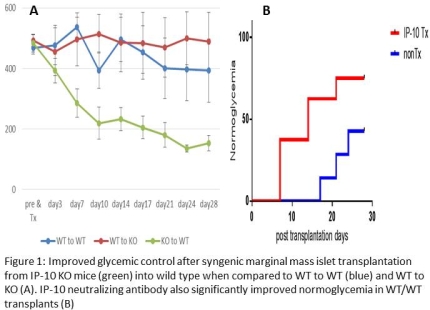The IFN-Gamma-Inducible Protein (IP-10/CXCL10) Is a Promising Target to Improve Endocrine Function Following Islet Transplantation.
1Islet Cell Laboratory, Baylor Research Institute, Dallas, TX
2Transplant Division, Department of Surgery, VCU Medical Center, Richmond, VA
3Transplant Services, Baylor Simmons Transplant Institute, Dallas, TX.
Meeting: 2016 American Transplant Congress
Abstract number: D49
Keywords: Inflammation, Islets
Session Information
Session Name: Poster Session D: Chimerism/Stem Cells, Cellular/Islet Transplantation, Innate Immunity, Chronic Rejection
Session Type: Poster Session
Date: Tuesday, June 14, 2016
Session Time: 6:00pm-7:00pm
 Presentation Time: 6:00pm-7:00pm
Presentation Time: 6:00pm-7:00pm
Location: Halls C&D
A significant mass of transplanted islets is lost very early due to an inflammatory reaction. CXCL10 is a chemokine that is highly expressed in islets during inflammatory stress. We tested CXCL10 inhibition to improve endocrine function in syngeneic islet transplantation and analyzed signaling pathways required to induce CXCL10 in islets. Isolated human and mouse islets and MIN6 beta cells and aTC1 alpha cells were analyzed for activation of CXCL10 gene expression by calcineurin/NFAT and MAP kinase signaling. Islets from C57BL/6 wild type (WT) or CXCL10-/- knockout (KO) mice were transplanted intraportally into either WT or CXCL10 KO diabetic recipient mice. Separately, CXCL10 neutralizing antibody was used to treat islets prior to and during infusion. Daily blood glucose levels and IPGTT were performed. Gene expression assays and promoter analysis indicated that CXCL10 gene expression is induced by NFAT-mediated translocation of p38 and JNK MAP kinases and chromatin modifying enzymes to the CXCL10 gene promoter in pancreatic beta cells. The transplanted islets from CXCL10-/- KO mice showed lower blood glucose within three days of transplantation (Figure A). The AUC of IPGTT in the transplantation of WT donor to either WT recipient or KO recipient were significantly higher than that of KO donor to WT recipient (52,900 ± 4,934, 52,100 ± 8,838, 28,089 ± 2,109, respectively; WT to WT vs KO to WT, p = 0.002). The CXCL10 neutralizing treatment group had a significantly higher normoglycemia rate than non-treatment group (75%, 43%, p = 0.04). CXCL10 expressed by islet endocrine cells contributes to islet graft impairment. NFAT and MAP kinases were required to epigenetically regulate the CXCL10 gene. Targeting signaling pathways that induce CXCL10 gene expression in islets and CXCL10 monoclonal antibody therapy may significantly improve islet function and transplant outcomes.
CXCL10 expressed by islet endocrine cells contributes to islet graft impairment. NFAT and MAP kinases were required to epigenetically regulate the CXCL10 gene. Targeting signaling pathways that induce CXCL10 gene expression in islets and CXCL10 monoclonal antibody therapy may significantly improve islet function and transplant outcomes.
CITATION INFORMATION: Yoshimatsu G, Kanak M, Balaji S P, Chang C, Darden C, Takita M, Lawrence M, Naziruddin B. The IFN-Gamma-Inducible Protein (IP-10/CXCL10) Is a Promising Target to Improve Endocrine Function Following Islet Transplantation. Am J Transplant. 2016;16 (suppl 3).
To cite this abstract in AMA style:
Yoshimatsu G, Kanak M, S PBalaji, Chang C, Darden C, Takita M, Lawrence M, Naziruddin B. The IFN-Gamma-Inducible Protein (IP-10/CXCL10) Is a Promising Target to Improve Endocrine Function Following Islet Transplantation. [abstract]. Am J Transplant. 2016; 16 (suppl 3). https://atcmeetingabstracts.com/abstract/the-ifn-gamma-inducible-protein-ip-10cxcl10-is-a-promising-target-to-improve-endocrine-function-following-islet-transplantation/. Accessed December 24, 2025.« Back to 2016 American Transplant Congress
